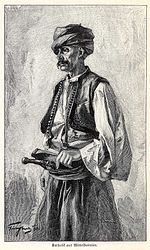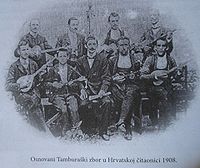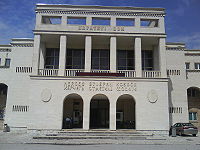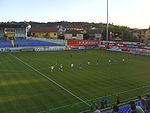- Croats of Bosnia and Herzegovina
-
Croats of Bosnia and Herzegovina
Hrvati Bosne i Hercegovine

 Hrvoje Hrvatinić
Hrvoje Hrvatinić





Total population 660,969[1] Languages Religion Mostly Roman Catholic
Related ethnic groups Other Slavic nations, especially South Slavs
Part of a series of articles on Croats  Subgroups
SubgroupsCroats of Bosnia and Herzegovina form one of the three constitutive nations in Bosnia and Herzegovina.[2]
There is no precise data regarding Bosnia and Herzegovina's population since the last war. Ethnic cleansing within Bosnia and Herzegovina in the 1990s saw the vast majority of Croats move and take up residence in the Federation of Bosnia and Herzegovina, as well as Croatia.[3] It is estimated that there are approximately 571,317 Croats in Bosnia and Herzegovina. According to 2000 data from the CIA World Factbook, Bosnia and Herzegovina is ethnically 14.3% Croat.[1]
Contents
History
Kingdom of Croatia
Croats settled into the areas of modern Croatia and Bosnia and Herzegovina in VII Century, finding Illyrians and Romans in that area, which they soon assimilate in the early seventh century, during the great migration of the Slavs.[4] They accepted Christianity and develop their own culture and art, they form their own political institutions and soon their own kingdom. The Croats formed two principalities: Pannonian Croatia in the north and Littoral Croatia in the south. Red Croatia, southern from Littoral Croatia, was land of few minor states. One of the most important events of Croats in Bosnia and Herzegovina in early medieval age is First Croatian Assembly held in 753 in Županjac (present-day Tomislavgrad). Second one is coronation of first King of Croatia Tomislav in cca. 925, in fields of Županjac. After that Croats lived in Kingdom of Croatia. Basic feature of that period in Croatia is isolation from European cultural and political flow which resulted in small number of secular monuments, exception are tens of thousands of Stećak. Territory of Bosnia and Herzegovina was divided in few independent administrative units: Bosnia, Hum, Travunia, Soli, Usora and Završje.
High and late middle age
In 1102 Croatia entered into a personal union with Kingdom of Hungary. As Bosnian king Tvrtko conquered part of Croatian Kingdom and as House of Šubić was weaken, Bosnia and Herzegovina feld under new state, Bosnian Kingdom, so did Bosnian Croats, even though, part of Bosnia and Herzegovina was still under Kingdom of Croatia. Regarding religion, Bosnia was closer to Croatia rather then Orthodox lands to the east, Bosnian Diocese is mention as Catholic in 11th Century, and later falls under jurisdiction of Archdiocese of Split and in 12th Century under jurisdiction of Dubrovnik Diocese.[5]. Another connection of Bosnia with Croatia is that Bosnian rulers always used Croatian political title "ban".[5] Specific religion in medieval Bosnia was Bogomilism and Bosnian Church, so some of the notable medieval Bosnian Croats were followers of this religion, like Croatian duke Hrvoje Hrvatinić.[6]
Ottoman Empire
Over the centuries Croatia saw its land shrink as the Ottoman Turks invaded Europe, and occupied Bosnia and much of present day Croatia for centuries to come.[7] Many Croats living in Bosnia converted to Islam during this time period,[8] and their numbers in areas shrank as many fled from fear of conversion and persecution, as the Christian folk were mistreated as low-grade citizens. The region henceforth became known as "Turkish Croatia" in Croatian literature.[9]
From 1815 to 1878 Ottoman authority in Bosnia and Herzegovina was decreasing. After reorganization of Ottoman army and abolition of Jannisaries, Bosnian nobility revolted, led by Husein Gradaščević who wanted to establish autonomy of Bosnia and Herzegovina and to stop any further social reforms. During 19th Century, various reforms were made in order to increase freedom of religion which sharped relations between of Catholics and Muslims in Bosnia and Herzegovina. Soon, economical decay happen and nationalist influence from Europe came to Bosnia and Herzegovina. Since state administration was very unorganized and since national conscience was very strong among Christian population, Ottoman Empire lost control over Bosnia and Herzegovina. On June 19, 1875 Catholic Croats, led by Don Ivan Musić, revolted because of high taxes in West Herzegovina. Soon after, Orthodox population also revolted in East Herzegovina, which led to Herzegovina Uprising. Turks were unable to defeat rebels, so Serbia and Montenegro used their weakness and attacked Ottoman Empire in 1876, soon Russian Empire done the same. Turks lost the war in 1878, and this resulted with over 150,000 Croatian refugees who went in Croatia. After that, after Congress of Berlin was held in same year, Bosnia and Herzegovina got new ruler, Austria-Hungary.
Late history
In the 19th century with the Croatian national reawakening movements, acts were made to unite all Croats into one state. Such an act was realized only in 1939, when the Croatian Banate autonomous within the Kingdom of Yugoslavia was formed, that included most of western Herzegovina and parts of central Bosnia. From 1941 to 1945, most of Bosnia and Herzegovina was a part of the Axis Ustasha Independent State of Croatia.[7] After 1945, the current state of Bosnia and Herzegovina was created under the Socialist Federal Republic of Yugoslavia as the Socialist Republic of Bosnia and Herzegovina. On April 8, 1992, the "Socialist" was dropped and was renamed the Republic of Bosnia and Herzegovina.[10]
Population geography
 The migration of the Croat people from Bosnia and Herzegovina after the Ottoman takeover
The migration of the Croat people from Bosnia and Herzegovina after the Ottoman takeover
Early population data comes from the Austro-Hungarian empire's censuses. After taking control of Bosnia and Herzgovina, the empire had a few censuses. After World War I the Yugoslav monarchy had two censuses.
Ethnic totals and percentages Year/Population Croats % Total BiH Population 1879 209,391 18.08% 1,158,164 1885 265,788 19.88% 1,336,091 1895 334,142 21.31% 1,361,868 1910 434,061 22.87% 1,898,044 1921 444,308 23.50% 1,890,440 1931 547,949 23.58% 2,323,555 Official Population Census Results - note: some Croats declared themselves as Yugoslavs in some censuses Official Yugoslav census data shows that the total number of Croats in Bosnia and Herzegovina has increased in almost every census, asides from between 1971 and 1981. Despite this, their total percentage of the total population has decreased.
Ethnic totals and percentages Year/Population Croats % Total BiH Population 1948 614,123 23.93% 2,565,277 1953 654,229 22.97% 2,847,790 1961 711,666 21.71% 3,277,948 1971 772,491 20.62% 3,746,111 1981 758,140 18.39% 4,124.008 1991 760,852 17.38% 4,377,053 Official Population Census Results - note: some Croats declared themselves as Yugoslavs in some censuses Prior the war in 1991, Croats made up 17.3% of the population, less than in previous years. From 1971 to 1991, the Croat percentage fell due to emigration into Croatia and lands of Western Europe. This fact should be taken into account for any estimation, regional or for Bosnia and Herzegovina as a whole.[11][12] Nevertheless, the fall in population percentage is only absent in western Herzegovina municipalities where Croats account for more than 98% of population.
The majority of Croats live in Western Herzegovina, Western Bosnia, Central Bosnia and Posavina (BiH Croats 1991). The war saw a large scale of ethnic cleansing and the migration of populations on all sides. Municipalities in which Croats are the majority in Bosnia and Herzegovina today: Mostar, Stolac, Ravno, Čapljina, Neum, Čitluk, Grude, Kiseljak, Kreševo, Livno, Ljubuški, Kupres, Dobretići, Odžak, Domaljevac-Šamac, Orašje, Posušje, Prozor-Rama, Široki Brijeg, Tomislavgrad, Vitez, Žepče, Usora, Novi Travnik and Busovača.
Culture
See also: Culture of Bosnia and HerzegovinaOne of the most important cultural institutions for the Bosnian and Herzegovinian Croats is the Croatian Cultural Society Napredak.[13] It helps educate Croatian youths by granting university scholarships, and works to promote culture. It has dozens of branches throughout Bosnia and Herzegovina and Croatia, as well as the Croatian diaspora. In the diaspora it is one of the main concert organizers for Croatian artists.
The University of Mostar is the only Croatian language institute of higher education in the country. Many of the nation's Croats also attend universities in Croatia, with the University of Zagreb being the most popular.
There are currently two major Croatian music festivals in the country: Etnofest Neum and Melodije Mostara. These festivals regularly attract the best native Bosnian and Herzegovinian Croat singers as well as top artists within Croatia itself.
Popular Croatian musicians coming from the country include Bijelo Dugme's Željko Bebek, Mate Bulić, Ivan Mikulić, Boris Novković, Vesna Pisarović and the group Feminnem.
 Divković's Besjede
Divković's Besjede
Literature
Croatian literature in Bosnia and Herzegovina has its foundations in the 17th century writer Matija Divković. From the 19th-20th centuries, Father Ivan Franjo Jukić, Antun Branko Šimić, Musa Ćazim Ćatić, are well known for their works.
In the Yugoslav period Ivo Andrić became the most well-known ethnic Croat writer from Bosnia and Herzegovina. He won the Nobel Prize in Literature in 1961.
Modern-day writers from Bosnia and Herzegovina today include Mirko Vidović, Željko Ivanković, and Miljenko Jergović.
Religion
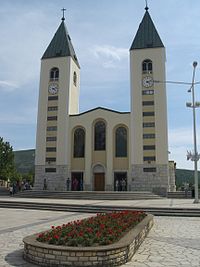 St. James Church in Međugorje.
St. James Church in Međugorje.
Croats form the core of the Catholic Church in Bosnia and Herzegovina. The metropolitan diocese is the Archdiocese of Vrhbosna. There are also dioceses centered in Banja Luka and in Mostar, which is the largest. Vinko Puljić is the current Cardinal and Archbishop of Vrhbosna.
The parish of Međugorje is a significant Marian shrine which attracts approximately one million visitors annually. It became a popular site of religious pilgrimage due to reports of apparitions of the Virgin Mary to six local Catholics in 1981.[14] Over a thousand hotel and hostel beds are available for religious tourism.
The Cathedral of Jesus' Heart in Sarajevo is the largest cathedral in Bosnia and Herzegovina,[15] and is the seat of the Roman Catholic Archdiocese of Vrhbosna. The other three Roman Catholic cathedrals in Bosnia and Herzegovina are: the Cathedral of Saint Bonaventure in Banja Luka, the Cathedral of Mary the Mother of the Church in Mostar, and Cathedral of the Birth of Mary in Trebinje.
There are numerous monasteries throughout the region. The oldest is the 14th century Monastery of the Holy Spirit located in Fojnica in central Bosnia. It houses a large library filled with many historical documents dating back to medieval Bosnia. Two other well-known monasteries are the Guča Gora Monastery and Kraljeva Sutjeska Monastery. Both are located in central Bosnia, near Travnik and Kakanj respectively. The rest of the monasteries in the region are: the Monastery of St. Anthony in Sarajevo, the Monastery of St. Mark in Derventa, Gorica Monastery in Livno, and the Assumption of Mary Monastery in Prozor-Rama.
Sport
Croatian-run clubs in Bosnia and Herzegovina number among the country's most successful. They are well-represented in terms of national championships in relation to the percentage of Croats in the population. In football NK Zrinjski Mostar, NK Široki Brijeg, NK Žepče, NK Posušje, and HNK Orašje are some of the most successful. Collectively, they have won three national Cup and five national Championships since national competition began in 2000. Other Croatian-run clubs are NK Brotnjo, NK SAŠK Napredak, HNK Ljubuški, HNK Sloga Uskoplje and others. The clubs themselves are often among the nation's most multi-ethnic.
Prior to 2000, the Croats ran their own First League of Herzeg-Bosnia in football. However, they have joined the UEFA-approved Football Association of Bosnia and Herzegovina's league system. Bosnia and Herzegovina has produced many successful internationals, both for the Croatian national team and the national team of Bosnia and Herzegovina.
Politics
See also: Politics of Bosnia and HerzegovinaHistorically, the Croats formed their own parties with the end of Ottoman rule. The Croatian National Community and the Croatian Catholic Association took part in the country's first elections in 1910.[16]
Currently, there are several Croatian political parties in Bosnia and Herzegovina, many corresponding to parties within Croatia itself. The Croatian Democratic Union, Croatian Democratic Union 1990, and the Croatian Party of Right are the most popular parties. The Croatian Peasant Party, New Croatian Initiative, Croatian Right Bloc, People's Party Work for Betterment are relatively minor Croatian parties.
In 2005, a conference on the Constitutional-law position of Croats in Bosnia and Herzegovina was held in Neum. It addressed ways to fix the political system.
References
- ^ a b CIA Factbook: Bosnia and Herzegovina
- ^ Bosnia and Herzegovina - Constitution
- ^ Kacowicz, Arie Marcelo & Lutomski, Pawel. Population resettlement in international conflicts: a comparative study. Lexington Books, 2007. p89.
- ^ Džino, (2010) p. 1
- ^ a b Noel, p. 15
- ^ (Bosnian) Ibrahimagić, Omer. (1996) Bosanska srednjovjekovna država i suvremenost, p. 100. Fakultet političkih nauka u Sarajevu
- ^ a b Tanner, Marcus (1997) Croatia: A Nation Forged in War.
- ^ Bove; Duhan-Kaplan, (1995) p. 293
- ^ Encyclopedia Britannica - Page 475. Hugh Chisholm
- ^ Uredba o izmjeni naziva Socijalističke Republike Bosne i Hercegovine. in: "Službeni list Republike Bosne i Hercegovine", god. I., br. 1, 9. aprila 1992., str. 1.
- ^ "Bosniaks or Muslims". Southeast European Politics Online. http://www.seep.ceu.hu/issue22/dimitrovova.pdf. Retrieved 2009-07-11.
- ^ "Academician Dalibor Brozovic interview". Hrvatska rijeć. http://www.ex-yupress.com/hrvrijec/hrvrijec6.html. Retrieved 2009-07-11 "chapter title: Important Croats Deserve Special Treatment - (second question) second paragraph)".
- ^ Napredak
- ^ Medjugorje.org – Overview of Medjugorje
- ^ Katolička Tiskovna Agencija
- ^ Worldmark Encyclopedia of the Nations: Europe. Gale Group, 2001. p69.
Literature
- Bove, Laurence F.; Duhan-Kaplan, Laura. From the Eye of the Storm: Regional Conflicts and the Philosophy of Peace. Amsterdam: Atlanta. ISBN 90-5183-870-0
- Džino, Danijel. Becoming Slav, Becoming Croat: Identity Transformations in Post-Roman and Early Medieval Dalmatia. Leiden: Koninklijke Brill. ISBN 978 90 04 18646 0
Notes
Ethnic groups in Bosnia and Herzegovina Bosniaks · Croats · Serbs
Yugoslavs · Jews · Montenegrins · Macedonians · Roma · Turks
Wikimedia Foundation. 2010.

